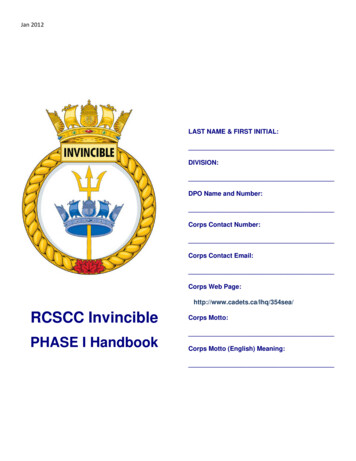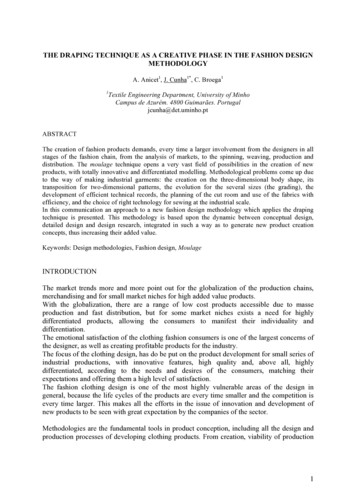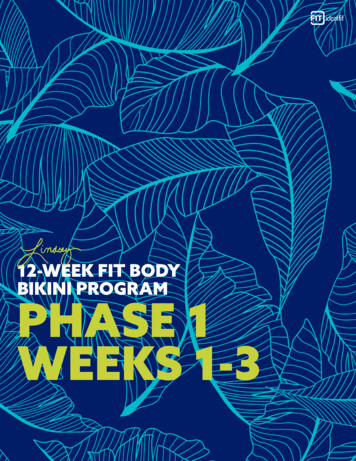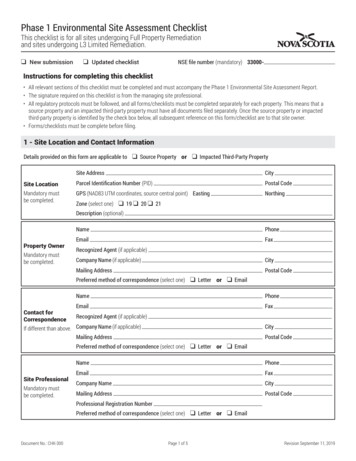
Transcription
Jan 2012LAST NAME & FIRST INITIAL:DIVISION:DPO Name and Number:Corps Contact Number:Corps Contact Email:Corps Web Page:http://www.cadets.ca/lhq/354sea/RCSCC InvincibleCorps Motto:PHASE I HandbookCorps Motto (English) Meaning:
Table of Contents231315212631333638404243444545454748List Corps OfficerList Corps DivisionsList Corps Divisional Petty OfficersList Corps Petty OfficersServe Within A Sea Cadet CorpsSummer TrainingDrillMarksmanshipSailingPhysical FitnessCitizenshipTeamwork / LeadershipThe Canadian NavyRopeworkNaval CommunicationBoatswain CallThe Ships Bell & The Ships ClockInvincible Ships RoutinePhonetic AlphabetA Sailors Dictionary / TerminologyDuke of Edinburgh’s AwardRCSCC Invincible, Chain of CommandFill in the Blanks for all of these peopleCommanding OfficerExecutive OfficerTraining OfficerAdministration OfficerSupply OfficerAssistant Trg OfficerInstructor (CV)Instructor (CV)Instructor (CV)(Name the Divisions) & Divisional Officer( ) Band Officer( ) Guard Officer( ) Div. Officer( ) Div. Officer(Name the Divisions) & Divisional Petty Officer( ) Band DPO( ) Guard DPO( ) Div. Officer( ) Div. OfficerSenior CadetsCoxswainBoatswains MateDrum MajorOtherOtherPage 2
1Serve Within a Sea CadetCorpsBy now you've started to become familiar with the regularroutine at your corps. You have probably figured out that SeaCadets are organized much like ships are organized in theNavy. The officers and Cadets in your corps are referred to asa "ship's company". Everything that you do within your corps isthe same as to being on a ship. The uniform that you wear, thewords that you use, and the ranks of the cadets and officersare all similar to those used in the Navy.In addition to offering you an exciting program, we arecommitted to providing a quality program. We have a visionthat we believe makes Sea Cadets the greatest youth grouparound.Vision of the Canadian Cadet MovementWe commit to develop in each and every Sea, Army and AirCadet qualities of leadership and an aspiration to become avalued member of their community. We reinforce valuesnecessary to prepare youth to meet the challenges of tomorrowand embrace the multicultural dimensions of Canada. To thisend, we offer dynamic training in a supportive and efficientenvironment where change is a positive and essential element.We further commit to attain this vision by living sharedCanadian values with particular attention to:Loyalty - The expression of our collective dedication to theideals of the Cadet Movement and to all its members.night you will be taught a variety of different subjects. Thelessons are all part of a training program in which every SeaCadet in Canada is participates in. There are many differentSea Cadet Corps all across the country. Some are very big,and some are very small, some are French speaking, andsome are English speaking, some are in small towns, andsome are in large cities, but all corps' are similar in the trainingthat they do.The normal routine on your regular training night will probablyinclude the following: Colours and Divisions - all cadets on the deck to raisethe Canadian Flag, be inspected and parade,signifying the start of your training night. This is similarto the start of a working day on a naval ship. Classes - three 30 minute classes covering a varietyof different subjects. Evening Quarters - all cadets on deck to lower theCanadian Flag, signifying the end of the training night.This is similar to the end of a working day on a navalship.The Sea Cadet OathAfter you get your uniform, your Commanding Officer may askyou to recite the Sea Cadet Oath as follows: “I hereby affirmmy loyalty to Her Majesty the Queen, her heirs andsuccessors. “ Usually all new cadets are called up to the frontof the parade square - all together – in a ceremony often called“swearing in” (repeating the oath). You will probably get yourcap tally and corps crest at this time. Ask your DPO to helpyou tie on your cap tally. You will need to sew on your corpscrest at home.Weekend AdventuresProfessionalism - The accomplishment of all tasks with prideand diligence.Mutual Respect - The treatment of others with dignity andequality.Integrity - The courage and commitment to exemplify trust,sincerity and honesty.All of your training is based upon active participation andstimulating activities in a naval environment. As you get toknow your corps, you will soon discover that the activities youdo meet the following aims of the Sea Cadet program: Develop in youth the attributes of good citizenship andleadership. Promote physical fitness. Stimulate the interest of youth in the sea activities ofthe Canadian Forces.Your regular training night is the one night a week that youmeet to conduct your mandatory training. During your trainingIn addition to your regular training night, there will be a numberof weekend activities planned for you. They will include manydifferent opportunities to travel and learn various Sea Cadetskills. A Sail Weekend might be the first, or an OnboardWeekend during which you can practice your new skills orlearn how to safely fire an air rifle. There are many excitingweekend adventures with which your corps will challenge you.There will be other weekend ‘exercises’ throughout the year.Routine and Standing OrdersBecause the Sea Cadet program is national, there are rulesand regulations that govern all the activities you do. Thisensures that all cadets receive the very best training possible.The officers that run your corps are very familiar with thesepolicies. They ensure that the program is interesting, fun, andsafe.There is so much to learn that you are probably wondering howyou can keep track of all that you need to know. This isaccomplished by publishing orders to help keep you informedat the corps level. These orders are called Standing Orders.Page 3
Standing Orders contain policies which guide the corps. YourCommanding Officer will issue Standing Orders and have themavailable for everyone to read. They contain information aboutthe instructions and regulations you need to know about.Standing Orders do not change very often. Do you knowwhere your corps Standing Orders are? These are the types ofthings that you will find in Standing Orders: Job Descriptions Chain of Command Cadet Protocol Out of Bounds Areas Corps Procedures Conduct and Discipline Dress Regulations Fire Orders Range Safety OrdersFamiliarize yourself with the instructions on how to wear it.Your uniform can only be worn when attending authorizedparades or activities, so don't give it to your little brother towear for Halloween! It is important to mark your name in all thepieces and exchange damaged or poorly fitting parts.How you wear your uniform is a direct reflection of how youfeel about being a Sea Cadet. Look at the senior cadets in yourcorps and notice how well they polish their boots, iron theiruniforms, and wear their hair. Take good care of your uniform,be responsible for it, and wear it with pride.When you are first issued your uniform you'll probably beoverwhelmed with all the parts and pieces. How do you polishyour boots, sew on your badges, and iron your gunshirt? Witha little practice, you'll be looking good in no time at all. Let's gothrough all the parts from head to toe and how to take care ofthem.Dress InstructionsSeaman's Cap or White TopRoutine Orders are usually published on a monthly basis asthe information they contain changes all the time. They areprepared and signed by the Executive Officer, on behalf of theCO, and include the following: Upcoming Activities and what to wear for them Personnel required for duty Information that you need to know about Items of general interestMake sure you find your corps Routine Orders and read themon a regular basis. They will help keep you informed aboutwhat's happening at your corps.The Sea Cadet UniformDid you ever notice how many different groups of people wearuniforms? Think about sports teams, the medical profession,clergy, factory workers, or even your favourite restaurant. Whatthey wear makes them easily identifiable as part of that team.Even if they don't wear uniforms they probably have somethingthat connects them to that organization, such as lapel pins, capbuttons, or identification cards. Worn so that the rim is one finger above youreyebrow. The front cap seam is centered directly over yournose. Your chinstay is to be sewn inside your cap at thelength that permits the stay to fit under your chin. Youdo not wear your chinstay unless you are told to. Hand wash your cap regularly in cold water anddetergent, using an old toothbrush to scrub the dirt off. Cap tallies with "Royal Canadian Sea Cadets" shouldbe centered so that the front cap seam is between the"I" and "A" of the word "Canadian". Tie your cap tally with a neat bow, not more than 7.5cm and not less than 5 cm across. The ends are ofequal length. Center your bow over the left ear vents. Cap tallies with corps names shall be worn the sameway, except centered accordingly.As a Sea Cadet, you are given a uniform, onloan, to wear as long as you belong to the organization.Page 4
Gunshirt May be worn during the summer with or without thetunic, but your tunic must be worn when proceeding toand from the corps, SCSTC or any official cadetactivity.Sleeves are pressed with a crease along the upperedge of each sleeve. Iron a vertical crease down the front of your gunshirt. Use starch for extra crispness.Lanyard Worn under the collar of your tunic. The knot is at the level of your first fastened button. Tuck the end of your lanyard into the inner corner ofleft breast pocket with the slack or bight hanging 8 cmbelow the level of the top of pocket.TrousersTunic Sleeves shall be roll-pressed with no creases. When your tunic is worn, it shall be fully buttoned,except for the first button down from the top. Ensure all your pocket buttons are done up. Do not fill your pockets with items so that they bulgeout. Be sure your belt is even, with no twists. Use a pressing cloth (thin towel, or pillow case) whenironing, to prevent shininess. Male trousers are worn with a black belt. Pressed so as to have creases down the center ofeach leg. Spray water on the pants with water bottle whenironing to make sharp creases, and don't forget to usea pressing cloth to prevent shininess. A pressingcloth can be a pillowcase laid overtop of your pantswhile you iron.Page 5
ParkasAnkle Boots 3-in-1 design. Black, drawstring waist with fleece lining. Can be worn on mandatory support weekends. Your rank is attached to your shoulders on slip-ons.GlovesToqueLaced Straight Across Method Worn with your topcoat or parka when the weather iscold. Worn so that the rim of the toque is one finger abovethe eye-brow. Wool or acrylic. The insignia is centered directly over your nose. Worn only with the topcoat or parka.Socks Grey wool socks. If you are allergic to wool, white sports socks can beworn under your grey wool socks, or a suitablereplacement used.Boots Laced horizontally from side to side. There are time-honoured methods to bringing yourboots up to the shiny standard you see on otherboots. It takes time and patience, but hard work willbring great results. Try the following: Remove dust and dirt from boot with a soft dampcloth. Use an old toothbrush to remove dirt from catwalks. Use a toothbrush, with polish, to blacken the catwalks.Catwalks Apply a moderate amount of polish to the area of theboot you will polish first. Use a polishing cloth or other soft cloth wrappedaround your index finger – tight, no wrinkles - anddampened with cool water or ‘spit’. You should work on one section at a time. Apply thepolish in a circular motion. Start with larger circles tocover the area with polish. Use smaller circles as thepolish works into the boot. Continue with the circularmotion until you can no longer see the circles formedby the polish. Breathing directly on the boots helps,so you see a fog, then continue making circles. You will have to apply many coats of polish in this wayuntil the boots have a high gloss. Be patient, good boots take time.Page 6
Webbing Worn by guards, gun crews,band members,quartermasters and membersof gangway staff while onduty, Chief Petty Officers,duty yeomen, duty buglers,members of side parties, anddrill teams. Webbing consists of whiteweb or plastic belt and whiteweb gaiters which go aroundyour ankles. White belts shall not be wornwithout gaiters. Gaiters shall be worn with thescalloped edges down,buckles to the outside, tabends to the back and tuckedinto retaining loops.Routine Training Orders of DressSea Training Orders of DressCategories of DressCeremonial Orders of DressService Orders of DressPage 7
Rank BadgesWhen you first join the corps you will be known as a New Entry(NE). After you receive your basic training and uniform, you willbe known as an Ordinary Seaman (OS). Neither of these rankshave badges, but after about 5 months you will be eligible foryour first rank badge of Able Seaman (AS). Then after another5 months, you will be eligible to become a Leading Seaman(LS). From here, you will progress through the cadet ranks,usually one each year, as follows: Master Seaman Petty Officer Second Class Petty Officer First Class Chief Petty Officer Second Class Chief Petty Officer First ClassQualification and appointment badges are worn on the upperright sleeve centered midway between the shoulder seam andthe point of the elbow. Qualification Badges are awarded uponsuccessful completion of summer training courses andAppointment Badges are awarded at the corps to indicatewhich job you have.Qualification BadgesBadges Will be sewn on the cadet tunic neatly, using a threadwhich blends in with the badge material (usuallyblack). Rank badges - Able Seaman to Petty Officer SecondClass - are worn on the upper left sleeve, centeredmidway between the shoulder seam and the point ofthe elbow.Able SeamanMaster Seam
The Sea Cadet Uniform Did you ever notice how many different groups of people wear uniforms? Think about sports teams, the medical profession, clergy, factory workers, or even your favourite restaurant. What they wear makes them easily identifiable as part of that team. Even if they don't wear uniforms they probably have something











